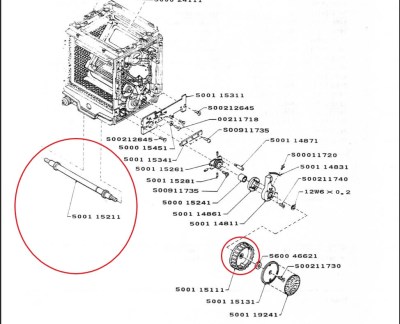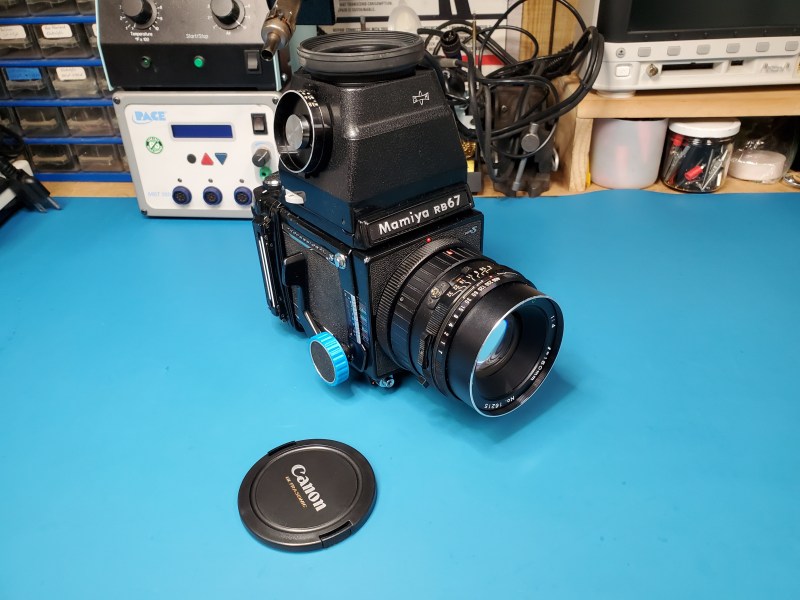
When it comes to professional medium format analog cameras, the Mamiya RB67 is among the most well-known and loved, ever since its introduction in 1970. Featuring not only support for 120 and 220 film options, but also a folding and ‘chimney’ style view finder and a highly modular body, these are just some reasons that have made it into a popular – if costly – reflex system camera even today. This is one reason why [Anthony Kouttron] chose to purchase and attempt to repair a broken camera, in the hopes of not only saving a lot of money, but also to save one of those amazing cameras from the scrap heap.
With the last of these cameras being produced well into 2009 (including the 1990 RB67 Pro-SD model), you’d figure that repairing them would be a snap, but with the world moving towards other (digital) cameras and film formats, most RB67s were produced during the 1970s and 1980s, spare parts are hard to come by. What does help is that the service manual is readily available, but as [Anthony] found, this is of only limited use.
What the service manual doesn’t tell you, for example, is how to remove the leatherette covering to get to the screws underneath. Here a heat gun and some careful prying with blunt tools did the joy, and uncovered the main issue with the camera: a bent focus rod. As the lucky owner of a lathe, [Anthony] considered milling a new one, but since the origin part was made out of brass, he reckoned the original part could be bent straight again with some care.
With that bit of surgery completed, that just left a definitely busted part: a focus knob. Rather than plastic, these are made out of Bakelite, which is more fragile than plastic, and replacement parts for this camera are more rare than hen’s teeth. Fortunately, the dimensions of the knob could be measured, a replacement knob printed in ABS and the original brass insert reused. Some careful reassembly later, and [Anthony] was in the possession of a fully functional Mamiya RB67 Professional.
















In a previous lifetime I owned a portrait studio and the RB67 was my mainstay camera. The 180mm lens was incredible with both excellent sharpness and exposure corner to corner, as well as offering excellent resolution. Coupled with a bellows focus (same as a view camera) allowed the equivalent of a near 1:1 macro capability, which with flowers and other delicate and fine detailed subjects could yield outstanding results.
Sadly, the camera and thousands of negatives/transparencies was lost in one of the California Wildfires a couple years ago. And, of course, having long-postponed task of digiizing those images, aside from the prints that family member have, all was lost but the memories.
A wonderful camera, though it weighed a ton, which was especially notable on some of my extended backpacking trips…
Wow, what a story. Sorry you lost your negatives :-/. The 150mm F4 lens that came with my RB67 had a large amount of balsam separation in the front doublet. On a valuable lens, I would usually attempt a repair, but there are far better copies of this 150mm lens for rock bottom prices. I’ll keep an eye out for a 180mm sekor-c lens though. Thanks for the input!
It’s 120 and 220 film sizes, no mm involved.
I have been lusting after a medium format SLR for some time now, alas a Mamiya is a little bit pricier than I am likely to obtain, and so I shall likely pick up something suitably Soviet in the future.
>> It’s 120 and 220 film sizes, no mm involved.
Fun fact, the 120 format is almost as old as commercial roll film photography itself, introduced with the standard Kodak Brownie around 1900. There was one _slightly_ older commercial format, found in the very early Brownies, but it only lasted a couple of years before it was replaced by the largely forward-compatible 120.
I was a pro photographer for a few years in the 80s and I lusted after this camera. My mentor had one she got when someone owed her money they couldn’t repay and they offered her the RB67 instead. I used it numerous times and simply loved the 6x7mm format, the huge and bright prism viewfinder which could be removed for studio use, and the comfortable ergonomics. Mamiya lenses of the time were not the best and weren’t improved till the RZ67 came out, but I never liked that camera as much as the RB.
” Featuring not only support for 120 and 220 mm film options, ”
What is 120 and 220 mm film?
120 and 220 film were both 60mm wide and the difference is the length of the roll (72 vs 144cm). 620 film was also the same size as 120.
And saying featuring not only support for 120 and 220 film sizes would be like bragging your Nikon SLR supports both 24 and 36 exposure film rolls.
Much as I loved the Mamiya 67 camera, I couldn’t read your post past that line.
Well. Stating 220 film as an option is legit as you needed a different back for your RB, or sometimes a different insert as most film counters would not count beyond the 10 shots on a 120 roll.
As you may be unfamiliar with the film type, there are no sprocket holes in the film and it has a paper backing throughout the whole roll for 120 film and just a paper start and end on the 220 roll. Depending on the camera used, you can get 8 (6×9), 10 (6×7), 12 (6×6) or 15/16 (6×4.5) out of a 120 roll. A 220 film would double that. (My Roundshot 28/220 even can do one frame taking up a whole roll)
So that is totally different from the variable amount of shots on a 135 film (you might be calling it a 35mm film)
Of course you have different frame sizes on 135 film as well, but unlike 135 film, 120 film had a fixed length.
Anyway, the whole thing is moot as there are no new 220 film rolls made afaik.
So just keep on reading and take less coffee in the morning.
The paper backing was essential for some cameras using 120 or 620 film. Frame numbers were printed on the paper and were visible through a little red window on the back on the camera. Without the opaque paper, the images would have been damaged.
The previous owner of my RB cut off the left focussing knob to make room for a vertical grip he made from a flash adapter. The camera is now very comfortable to handle and carry around (it’s a heavy beast)
That reminds me of the large handle Pentax 67 cameras. Well, if you ever change your mind, you can always 3D print a spare knob and use a lamp nut to fasten it in place if the focus shaft is still there.
The biggest problem to day with even excellent condition RB67’s is the foam rubber that the mirror closes on and forms light stops in the camera and the film holders. There are kits available from some sellers in Japan but it takes very careful work to do the job.
There are backs that will take a 4×5 film holder and Polaroid. These have always looked like a good place to start for making a DIY digital back. Maybe a large sensor or a motorized scanner with one of the very long linear detectors from scanners.
There are also kits with new leather of various colors. Including tips on removing the old material. https://hugostudio.com/index.html
That is an interesting idea, considering the film for the RB67 Polaroid back was semi-custom. The film has been out of production for many years and there are not too many other uses for the RB67 Polaroid backs…
I have a UPD3768D Linear CCD from NEC that you can find on Aliexpres, etc. 7500 pixels that span 69mm. That is 600DPI on a full A3 paper. I had red. blue, and a pair of green arrays so basically it is right for the 6×7 or 2 and 1/4 by 2 and 3/4 inch of 120 film. That and either the Polaroid or the 4×5 back are my starting points and with the movement mechanics from from a CD or DVD drive. The image could be 7500×6428.
Ahhh I remember this camera…
“Lubb, Thump. Lubb, Thump. “
Hahaha. It definitely has a very distinctive, methodical operation.
That’s an incredibly detailed write-up!
Loved all the details, great work!
Many thanks :D
Love the attentive to detail on this – from carefully mantining the leatherette to the satisfying feel of the high density print. Excited to check back and see some photos from it!
Thanks a bunch! I will surly update the write-up once I finish installing the new seals :D
Surprisingly, the bellows was in very good shape. I tested it with various light sources inside the camera with the lights off and I could not discern any pinholes in the bellows material. Also, it seems you can purchase newly produced bellows for the RB67, which is excellent news all around.
That gives your camera character! It’s seen things! I tend to like cameras with signs of wear because I don’t feel bad if I add more. I know that sounds odd, but I wont mind if I put a camera with wear down on a brick or stone wall. But if the camera looks babied and the paint is mint, I certainly would not want to do that!
I met my mentor when still in high school (71). He started me at the bottom. He wasn’t brand conscious, so I asked him why he liked Hasselblad cameras, and he said in this business, you use the same camera as your friends. That way you can borrow from each other. Aha! Funny thing, he always had to sign a receipt. I asked about that, and he said that it was in case he died before he returned it. That way the owner could get it back from his estate!
Haha. That’s some sound reasoning right there. If you can get access to free lenses, why not!
I’ve had an RB67 since the mid-1980s when I was studying photography. Simply wonderful cameras, but maintenance is costly. Replacing the felt or foam light traps is necessary every so often, and that’s a couple of hundred dollars.
There’s quite a few 2nd-hand lenses available in Japan on fleabay, the prices seem reasonable.
I looked into digital backs for them – there are cheap ones at about AUD$1,500, or genuine Mamiya Leaf backs for about AUD$20,000. One day……..
And then there’s difficulty finding batteries for the Gossen lightmeter. You can’t get mercury cells anymore, so you’ve got to use silver or alkaline cells with an adapter, but they’re a different voltage and you have to re-calibrate it.
Despite all that, it’s still fun to get out with a roll of film and explore.
“Rather than plastic, these are made out of Bakelite”
Because Bakelite is…?
I’ll bookmark the repair page. The Mamiya RB67 is one of my “bucket list” cameras.